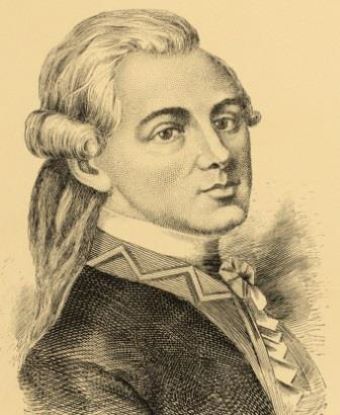Last updated: July 23, 2020
Person
Daniel-Hyacinthe-Marie Lienard de Beaujeu

Daniel-Hyacinthe-Marie Lienard de Beaujeu was a Canadian military officer in the colonial regular troops. His military career began at an early age. With experience and successes, he rose to the position of captain. He was made commander of Fort Niagara in 1749 and Fort Duquesne in 1755, although he was killed in the Battle of Monongahela before he assumed command of the latter.
During his time as the commanding officer at Fort Niagara, Beaujeu came to understand the value of good relationships with the local American Indians. Military and trade concerns were forever at the forefront of French and English interests in the Ohio River Valley. Like Céloron de Blainville, Beaujeu recognized that the British traders who had recently moved into the area, and who were offering lower prices on trade goods, were detrimental to New France’s trade relations with American Indians.
Beaujeu arrived at Fort Duquesne in late June of 1755 to assume his commanding position after an eventful journey. By this time, however, the officers at Fort Duquesne were aware that a formidable British force under General Edward Braddock was enroute. Braddock’s campaign constituted a determined effort on the part of the British to push the French out of the Ohio River Valley. The British were particularly incensed by the recent defeat of a their force led by George Washington in the Great Meadows in 1754.
Beaujeu led the French response to Braddock’s threatening approach. He needed the assistance of his American Indian allies who were unwilling to engage the overwhelming British force. But, Beaujeu knew how to convince them. His speech roused them to action, displaying his leadership skills: “I am determined to confront the enemy. What – would you let your father go alone? I am certain to defeat them!" Beaujeu departed Fort Duquesne on the morning of July 9th with 637 American Indian warriors, 146 Canadian militiamen, and 108 colonial regulars.
That same day, Beaujeu's French, Canadian, and American Indian force confronted General Braddock’s men in the bloody Battle of Monongahela. The encounter was rather unexpected for both sides. Beaujeu was killed early in the fighting by Braddock’s artillery. But he had succeeded in bringing a French army into battle, and they went on to win a stunning victory.
Although the French won the battle, it was the beginning of the end of French influence in North America.
Author:Catarina Hurtado
Sources:
Clary, David A. George Washington’s First War: His Early Military Adventures. New York: Simon & Schuster, 2011.
MacLeod, Malcolm. “LIÉNARD DE BEAUJEU, DANIEL-HYACINTHE-MARIE.” In Dictionary of Canadian Biography. Vol. 3. University of Toronto/Université Laval, 2003. Accessed June 9, 2020. http://www.biographi.ca/en/bio/lienard_de_beaujeu_daniel_hyacinthe_marie_3E.html
https://www.nps.gov/common/uploads/teachers/lessonplans/F&I%20Unit7%20French%20Biography%20Cards%20(508).pdf
https://www.findagrave.com/memorial/128635767/daniel-lienard-de_beaujeu
